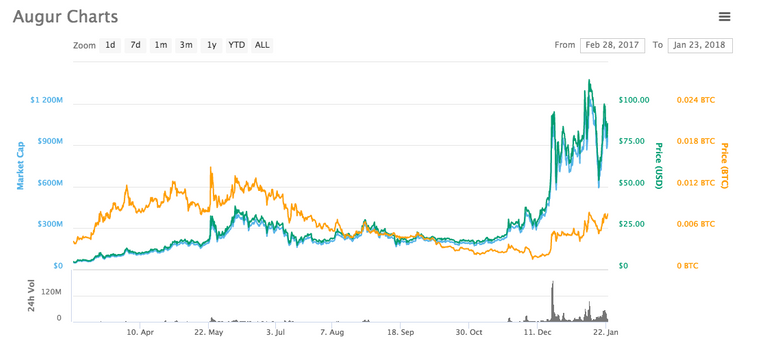The age of sports betting is about to get it’s biggest disruption which is going to reverberate globally thanks to the rise of blockchain technology led in the space by Augur.
The rise of sports betting and prop betting over the past five years has been astronomical in Australia due to weak regulation and the classic Australian love of ‘the punt’. But this is the beginning of the end in Australia which will quickly emanate globally.
It’s been an ugly watch for onlookers who have witnessed a proliferation of European bookmakers to Australia headed by Paddy Power, William Hill and Ladbrokes who have took over Australian brands and their customers.
But with William Hill set to depart Australia in February 2018 after haemorrhaging losses and Crown Resorts exiting Crownbet, industry powerbrokers have already identified the passing of Australia’s golden age of sports betting.
Augur (ticker: REP) – Removing ‘vig’ and centralisation
Built on the Ethereum network, Augur is a peer-to-peer application which enables users to trade on predictive markets using their REP token as cryptocurrency.
Like most blockchain-related platforms and applications, the key element to Augur’s success will be decentratilisation which enables users to bypass the two biggest issues with sportsbetting – vigorish (aka: vig) and centralisation.
(A lack of) Centralisation is key to the Auger platform because it will enable users to create markets themselves and sell the odds/payout to other users. It is essentially betting peer-to-peer without the use of a bookmarker in between.
By doing so, users are likely to receive better odds than what is traditionally offered by a bookmaker who must take vig (the house’s cut) out of the odds to make a profit.
Under centralised markets, a bookmaker will offer the odds of a coin toss at $1.91 which accounts for 4.5% vig and is the same centralised control who ban winning punters.
Eg, if one user bets $100 on heads and one user bets $100 on tails, the bookmaker will only pay out $191 of the $200 they held on the market.
By allowing users to frame markets directly with other users, Augur is essentially enabling individual to start their own sports books without any form of license or pay tax on turnover.
Predictive markets to extend miles beyond sports
The entire global financial economy is based on predictive markets.
When people buy stocks, they do so predicting the value will increase.
When a company launches a new product, they do so predicting people will buy it.
When a company looks for oil, they do so predicting they will find where they look.
Because Augur will let users create their own predictive markets whilst betting with peers, any occurrence which can have a measurable outcome can be framed as a market peers at minimal expense; and remotely.
Difficulties Augur will face
Like most decentralized applications currently in development, Augur still doesn’t have a product yet but based on the companies regular developer updates and ability to meet their own timelines, they will be one of the first dApps to launch in either Q1 or Q2 of 2018.
As one of the earlier blockchain applications with practical use, Augur already has a sound following but in the initial stages of launch, predictive markets will face liquidity issues.
Because users will need to stake their REP when creating the markets, there will be very limited liquidity in markets at first. Traditional bookmakers may gradually creep into the platform as a means of limiting their on-book liability but this is likely to take some time.
Market manipulation is also very possible on a platform like Augur where outcomes to events may already be known prior to the completion of an event, ala: match fixing. But even so, these problems plague traditional prediction markets which is why users should always be wary of trading in obscure markets.
Augur Price Analysis

Augur/USD vs Augur/BTC (March 1, 2017 to Jan 23, 2018) Source: Coinmarketcap.com
August can be traded on most major exchanges having been in circulation since January 2016.
With market capital over $900,000,000 USD, they are likely to float around the top 50 coins for several years to come.
What makes the value of their REP token attractive is the hard cap of 11,000,000 REP tokens which have shown sound growth despite the product still being yet to launch.
As more liquidity enters their predictive markets, the value of each REP token should increase as predictive markets move away from traditional bookmakers whilst Augur becomes more accessible to more people.
Currently trading at $84.78 USD, REP has taken a small hit on it’s price in line with the wider market but it’s dip is far less than the market in general following the early January FUD and the settlement of BTC futures contracts.
From BTC’s high on December 20, 2017 of $17,850 to their current price of $10,892, there has been a drop of 38.98%.
In comparison from REP’s high on the same day of $107.48 to their current price of $84.78, Augur’s token has fallen by 21.12% which is significantly less than the market leader.!
Coins mentioned in post:
Thanks coin.info.
Good example of how Augur is resisting the market dips and setting up for an outbreak.